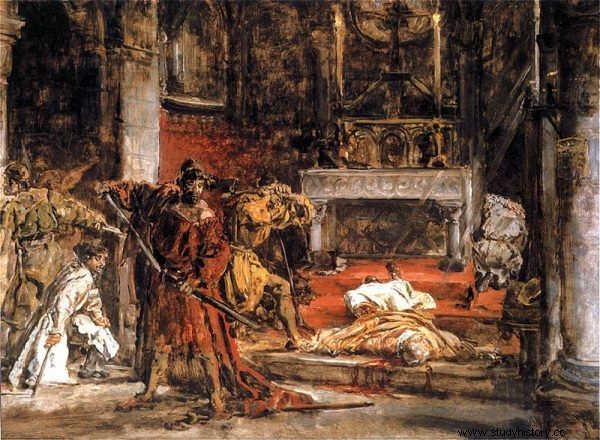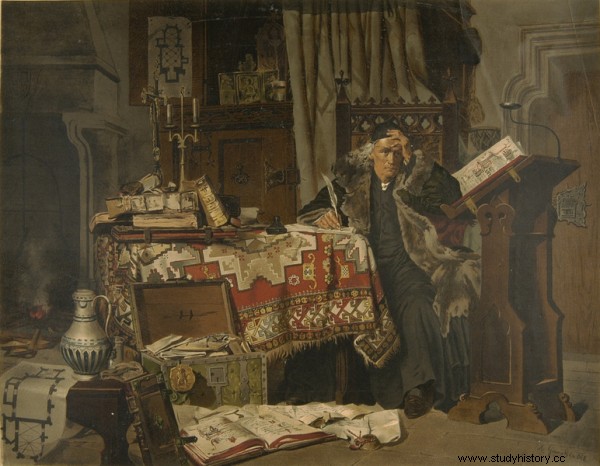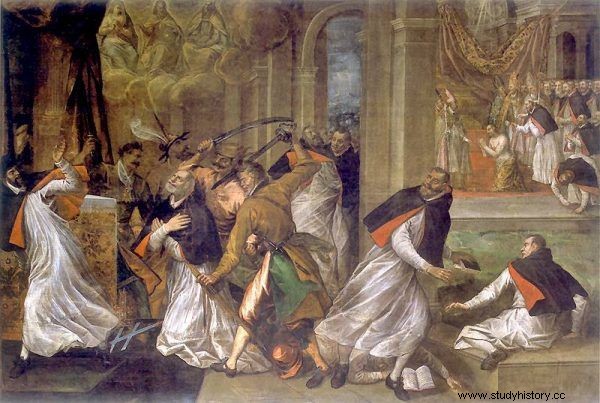Resurrected corpse as a witness in court? Necromancy as a source of pride and a method of making money? When it came to privacy, no measures seemed to go too far. And apparently one of the patron saints of Poland also knew about it.
Little is known about Saint Stanislaus. Being the bishop of Krakow around 1079, he fell into conflict with King Bolesław the Bold, which he paid with his life. And, in fact, this is where the facts end. It was not until the 13th century (after a century with a poultice!) That the Krakow clergy hailed the bishop as a martyr. His image was created in a hurry, so that the enigmatic saint could outdo Poland's rival patron - Wojciech.
For this Orwellian rewrite of history hagiographic stories about Stanisław came in very handy. He was already praised by the chronicler (and at the same time - one of the successive bishops of Krakow), Wincenty, called Kadłubek in a work written around 1208. The history was further developed and filled with details by the Dominican, Wincenty of Kielcza, who worked in the mid-13th century.

Artistic depiction of the murder of St. Stanisław by Jan Matejko (source:public domain).
The work was not in vain. Stanisław was raised to the altars in 1253, and legends about him have survived to this day. Church propagandists should not be proud of all of them, however.
The authors of Stanisław's lives went into a corner. They wanted to glorify the bishop so much that they attributed him to ... dabbling in necromancy and thus the art of bringing the dead to life!
The knight is resurrected
Here the bishop took the dead knight out of the grave and resurrected him to testify before the royal court. It was about finances , namely the deed of ownership. According to the story, Stanisław had to prove in court that he had legally acquired the village of Piotrawin from a certain Piotr Strzemieńczyk.

The knight was already dead, the bishop did not have the necessary documents, and the deceased's family was not going to take his word for it. Hence the whole complaint to the king. In this situation, the saint meditated for a moment, then decided that… peace of the soul of the deceased was for nothing. Neither was he evidently concerned about the threat of sacrilege or the second commandment. He decided to resurrect the knight Peter!
It is astonishing that the clergy responsible for similar legends saw nothing wrong with turning your head on God and summoning someone from the afterlife for a purpose as trivial as proof of ownership. Although who knows, maybe our generation has become sensitive to similar problems after the scandals related to the activity of the Church Property Commission for the Catholic Church? But let's go back to Stanisław.

The outstanding chronicler Jan Długosz in a painting by Antoni Gramatyka (source:public domain).
From the version of the story written by Jan Długosz himself we learn that:
(...) leaving the church, [the bishop] ordered the earth to be excavated and the tomb of the late knight Peter to be opened ; and when the corpse appeared, which had been rotting for three years, among the multitude of priests and people, he fell to the ground and poured tears on his face and prayed earnestly to God.
As Długosz writes, the saint recalled in his prayer the biblical resurrection of Lazarus, and then said: rise Peter from the dust and come back to life that you bear witness to the truth!
Judgment of the Living Dead
The knight got up without a murmur, and Stanisław led him to Bolesław. Of course, the king and his entourage dropped their jaws at the sight of such a miracle ( almost lost their minds, so that they dared not say anything or make inquiries ). The resurrected knight not only testified that Stanisław was telling the truth, but also insulted his relatives for starting a scandal against the Church.
Finally, the bishop asked Peter if - since he had already been raised - he would not want to live for a few more years. However, he thanked for such a grace and preferred to return to purgatory. He lay down in the tomb and, laying his body of the spirit in it, gave up and Stanisław sang with his clergy most piously psalms according to the Catholic rite and commended his soul to his God, covered his body with earth.
This article has more than one page. Please select another one below to continue reading.Attention! You are not on the first page of the article. If you want to read from the beginning click here.
The miracles of the bishop
Whoever does not believe (and it is really hard to believe ...), can visit the gothic chapel at the church of St. Thomas the Apostle and St. Stanisław in Piotrawin. It was built in the 15th century on the site of a former temple, dating back to the times of the necromancer bishop. There you can see the 17th-century tombstone of Piotr and an older, medieval one - now embedded in the wall.

Is it in this church that the famous resurrection took place? (photo:Epegeiro, license CC BY-SA 3.0 pl)
There is also a lime tree next to the temple, the successor of the unusual tree allegedly planted there by Stanisław. After finishing the matter with the knight Peter, the bishop plucked a twig from the tree and planted it with the top to the ground with the words: Grow in remembrance! So the necromancer decided to celebrate his court performance. In fact, the linden tree in Piotrawin looked as if it was growing with its roots up. However, we can admire the original one only in photos and pictures, because it broke up in 1930. Today only her "daughter" grows in Piotrawin.
However, anyone who thinks that this is the end of the necromancer miracles with Stanisław would be wrong. It acted and brought it to life even from beyond the grave. It was thanks to him - as reported in the thirteenth-century hagiographies - that the son of a certain Ryszard Lombardczyk, who died shortly after birth, was resurrected in Krakow (so that he could be baptized, and then quickly died again). Due to a pebble from Stanisław's grave, Wicher, the son of a knight from Polikarcice, is said to have revived. And also a child of a Hungarian from Mysławczyce.

Krakow patron of Poland
In a symbolic way, Stanisław also contributed to the reactivation of the "deceased" Kingdom of Poland. The chronicle of Master Wincenty, known as Kadłubek, says that the bishop's body, dismembered at the king's order, was regrown. Poland, divided into districts, was to merge in the same way.
With the fact that - let us emphasize - under the patronage of Krakow and the Krakow saint! Not Czech Wojciech from Gniezno. Not St. Lambert (promoted by the first Piasts), nor St. Florian (who eventually became only the patron saint of firefighters).

Tomasz Becket's vision of death by Tommaso Dolabella. Was the story of the murder of a British bishop an inspiration to create the legend of Saint Stanislaus? (source:public domain)
And that the version about the murder and dismemberment of Stanisław by the furious king Bolesław strangely resembles the story of the English bishop Thomas Becket, made famous in Europe, who was killed in front of the altar in 1170 by the henchmen of Henry II Plantagenet? Well, this saintly story about a Krakow martyr comforts hearts more than the sad version of punishing a bishop for cutting down his members for treason.
Even if it is as "true" as the stories of Stanisław's hagiographers about the resurrection of the knight Piotr, it is difficult to win. Or maybe the living dead stuck in the closet of Polish history shouldn't be touched at all? ...
***
Polish hunters of the living dead, disgusting rituals of Caribbean shamans and crimes committed at distinguished courts in Europe. Adam Węgłowski travels continents in search of stories that will keep you awake at night. Only now you can buy the new book "Historical Curiosities" up to 30% cheaper!
